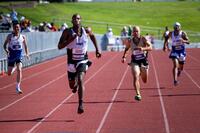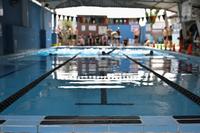Many people have read the article How Proficient Should You Be at Swimming?, which addresses the level of swimming required for basic military training and advanced training programs, like rescue swimmer, Air Force PJ and Navy SEAL. But it fails to discuss what workouts will help you master proper techniques and get you comfortable using the combat swimmer stroke (CSS).
The good news is that learning any stroke will help you get more comfortable in the water. Check out these videos of people learning how to swim the freestyle or crawl stroke, breaststroke and even elementary backstroke. Each one will help you master proper body position in the water.
As you get better, you can add distance and actually call it a workout. Once you are doing swim workouts, you are well on your way to building a high level of comfort in the water.
Work Set, Rest Set, Active Rest Set
Many first-time swimmers have the endurance to swim across a 25-meter pool and back, with a rest stop afterward. This is a fine pace on 50-meter sets for beginners. Build up to five sets, then push yourself to perform 10 in a workout.
Your next goal is to keep moving and learn a rest stroke that works for you. For example, you might start a workout with freestyle, then rest with the breaststroke, CSS or even backstroke. Your goal is to get comfortable being winded in the water while still moving, regardless of the stroke you need to swim.
As you progress and 10 sets of 50 meters become easy, double down and do 10 sets of 100 meters. You may need to rest again just as before, but eventually you will be able to push through again.
Remember that your goal is to keep moving.
Swim and Add New Skills
Once you get comfortable with longer sets of swimming, it's time to up your game and add other water skills that can save your life. Exercises, such as treading water with hands and feet, bottom bouncing and the dead-man float, are great skills to know. You will see these again in any military swimming class you take.
Some of their favorite workouts include swimming 100-200 meters while timed. Afterward, you'll have to tread water for however long it took you to swim that distance. Treat treading like vertical swimming; it is not easy.
If you go into a swim test thinking treading is easy, you'll be quickly disappointed if you have not practiced long bouts of it. During your next set of workouts, time yourself on different skills like the bottom bounce (which is best performed in an eight- to 10-foot pool), an underwater swim or the float. If you are lean, you may find that it is easy to bounce but hard to float. If you have a few extra pounds, it will be difficult to bounce but easy to float.
As you progress, try treading water with no hands. Only use your legs to keep you up. Here are some workouts to help build your comfort in the water:
-
Workout #1: Time yourself in a 50-meter swim. Repeat 5-10 times; rest as needed. Build up to 500 meters of total swimming distance.
-
Workout #2: Swim 50 meters for 5-10 sets, but limit rest to an easy breath-catching stroke and see whether you can swim the entire distance nonstop. Build up to 30+ minutes of swimming.
-
Workout #3: Once workouts #1 and #2 are easy to finish, add more sets or more distance; swim 100 meters and repeat 5-10 times. Practice life-saving drills between sets of swimming for as much time as it takes you to swim your workout distance. If it takes you two minutes to swim 100 meters, then do a set of two minutes of treading. The next set can be the bottom bounce, and the next set can be the float.
Enjoy building up your confidence. You have to start somewhere with your water confidence, but over time, you can turn these workouts into one- to two-hour swims.
Stew Smith is a former Navy SEAL and fitness author certified as a Strength and Conditioning Specialist (CSCS) with the National Strength and Conditioning Association. Visit his Fitness eBook store if you're looking to start a workout program to create a healthy lifestyle. Send your fitness questions to stew@stewsmith.com.
Want to Learn More About Military Life?
Whether you're thinking of joining the military, looking for fitness and basic training tips, or keeping up with military life and benefits, Military.com has you covered. Subscribe to Military.com to have military news, updates and resources delivered directly to your inbox.


















